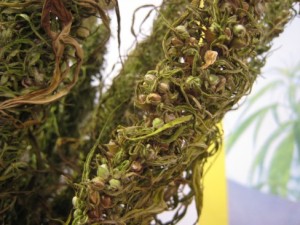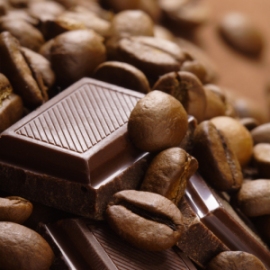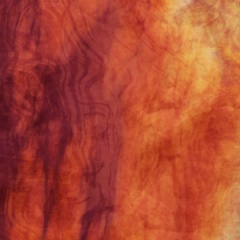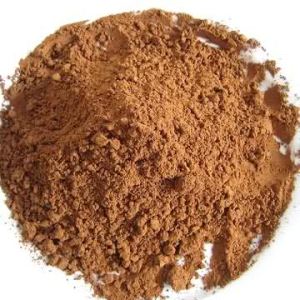Close your eyes, and imagine that you’re lying in a field on a hot summer’s day. All around you are tall blades of fresh, green grass, but this is a very different sort of field. Your head rests on large bales of hemp, large pods of cocoa sprout up around your body next to black stalks of Madagascar vanilla, and the patchouli earth is a mix of sweetness and dryness. The sun shines on your face, but brown-red clouds shower cloves and nutmeg down on you, while a dry wind blows a soft smokiness from the ebony trees circling the field. Dotting the landscape all around are picnic tables covered by tobacco leaves that have been lightly drizzled by honey. As you doze in the warmth and golden sweetness, the scenery changes and you’re carried off in a cloud of cloves, nutmeg and chocolate, threaded through with patchouli and dry woods, and a dash of vanilla. Welcome to the special world of Coze.
Coze is a gorgeous, cozy eau de toilette from Parfumerie Générale that I simply loved, a fragrance that straddles the line between an oriental and a gourmand in a perfectly calibrated mix of spices, warmth, dryness, and sweetness. I’d heard a lot about Coze from a friend who strongly encouraged me to try it, raving about its patchouli aspects and its coziness, but I had held off for fear of the ISO E Super that Pierre Guillaume seemed so fond of in his other fragrances. He was right, I was unnecessarily leery, and I wish I had followed his advice sooner. Coze has neither ISO E Supercrappy nor any of the excessive, cloying, diabetic sweetness that is the hallmark of Pierre Guillaume’s Phaedon line. Instead, Coze is beautifully balanced, and the perfect sort of “Cozy Scent,” my second favorite category of fragrance. True, there are a few flaws which prevent it from being perfect, but, in the overall scheme of things and for the price, I think Coze is fantastic. It is definitely going on my “Must Buy” list.
Coze is the second in Pierre Guillaume’s numbered line of fragrances (02) and is an eau de toilette that was released in 2002. Parfumerie Generale describes the scent as follows:
Woody Oriental Tobacco – Spicy and Vibrant
A shortened olfactory pyramid for this first scent based on essential Canapa Sativa Seed Oil. [¶] The olfactory complexity of this new extraction, which Parfumerie Générale has the exclusive rights to, deserved a bold and original construction capable of bringing out all the facets of this rare and precious ingredient. In place of the head note, the disconcerting, captivating Canapa Sativa heralds, a rich, warm juice.
Its heart is vibrant with spices and precious wood : pepper, pimento and coffee fuse and flame to announce the sensuality of ebony, the rich, bewitching sweetness of chocolate and the infusion of Bourbon vanilla pods.
Indian Hemp, Patchouli, Spices, Blond Tobacco.
The succinct and complete list of notes, as compiled from that description, seems to be:
canapa sativa seed oil [Indian hemp], pepper, pimento [chili], coffee, ebony wood, chocolate, bourbon vanilla pods, Patchouli, Spices, Blond Tobacco.
Fragrantica, however, adds in cedar and sandalwood, something that I have not seen on any other sites. Luckyscent, however, omits both the patchouli and tobacco. Meanwhile, OsswaldNYC mentions both, but also brings up nutmeg as well. Whatever the specific details may be, one thing I can tell you is that Coze is reported to have been reformulated. It is something mentioned by quite a number of people, from those commenting on Luckyscent to my friend who loves Coze passionately but who mourns its change in potency and richness. (He says it is “25%” less dense.) Finally, I should add that I have no clue what “hemp” may smell like beyond its dried grass characteristics. I’ve come across hemp rope, but all I took away from it was the dried aspect.

Photo: MedioImages Photodisc, on Fine Art America. http://fineartamerica.com/featured/extreme-close-up-of-wheat-growing-in-field-medioimagesphotodisc.html
Coze‘s opening takes me to a field of sunshine and warmth. The perfume opens on my skin with a fierce, concentrated explosion of nutmeg and cloves, then black pepper, chili flakes, and patchouli. In their trail is the sweet aroma of dried tobacco that smells like tobacco leaves drizzled with honey after being soaked in rich vanilla extract. The whole thing is lovely, but becomes even better when the cocoa arrives. It resembles rich slabs of semi-sweet chocolate, as well as dusty cocoa powder. As the Madagascar vanilla and chocolate infuse the top notes, the spicy patchouli turns earthier. It smells like sweet, slightly wet, loamy soil, but also something dustier and drier. Tying the whole thing together like a bundle are sweet grassy notes, presumably from the hemp.
Coze is sweet, but it’s also too dry to be a true gourmand fragrance. Nothing about it resembles dessert, despite the chocolate and vanilla elements. The fragrance is much more like an Oriental at the start with gourmand touches that have been carefully calibrated to be on the drier side, rather than the heavily sweet. There is a subtle smokiness to the notes, perhaps from the ebony wood. Tendrils of a Bakhoor-type of incense weave around the cloves, nutmeg, patchouli and chocolate, leaving me quite mesmerized by the overall effect.
I don’t know what is the better final touch: the honey drizzled on the blond tobacco, or the subtle traces of expresso coffee that join the festivities after 10 minutes. The whole thing is luscious, rich, smooth, and deep, a combination of notes that is utterly like catnip to me. In fact, I rather feel like a cat who — dazed and drugged — wants to stretch out in the warmth of the fiery spices, dryness, sweetness and darkness. Coze is neither light nor dark in its shadings, but a mix of both with the light tobacco and ebony woods. Yet, the predominant colours are earth tones led by the fiery, red-brown cloves. Somewhere in Tuscany, there is a painter trying to capture these exact shades of umber, burnt umber, sienna, terracotta, expresso, sun-bleached grass, and golden sunshine.
I grant you, I’m both a patch head and a lover of cloves, but neither is the sole reason why I find Coze to be glorious. The more I wear it, the more time passes, the less I can decide what appeals to me most. Like a spoilt child indulged in a candy store, I’m dazzled by the array of choices, notes that feel tailor-made for me. I’ve changed my mind on the tobacco being the coup de gras, as the note is far too subtle and minor in the overall scheme of things. I settle on the chocolate for a brief moment, but, being fickle, I change my mind again. No, I think it really may be the cloves. God, they’re fantastic. Coze’s opening is like a richer, more concentrated version of Caron‘s legendary Poivre Pure Parfum which in its modern form is much weaker on the chili pepper, cloves, and fire. Coze has all that, minus Poivre’s powderiness.
The cherry on the cake is the smooth cocoa powder and the dry vanilla, mixed with the patchouli’s earthiness and the hemp’s grassy notes. They are supplemented by a touch of coffee which, unfortunately, is extremely weak, muted and muffled. Most of the time, it feels like a mere by-product of the other elements, the result of the patchouli and chocolate combined, more than actual coffee, per se. Coze would be far better with more of the note, but perhaps this is the result of reformulation. Still, the fleeting suggestion is a wonderful touch when it briefly pops up in the opening 30 minutes.
Everything about the darker, woodier or spice elements seems intentionally designed to ensure that Coze never becomes cloying. I generally struggle with really syrupy fragrances, and I find Pierre Guillaume’s Phaedon line (especially Rouge Avignon, but also Tabac Rouge and Pure Azure) to be well-nigh unbearable in overdoing the sugariness. Thankfully, Coze is nothing like that. Your first thought when you smell it is not about the sweetness, but cloves, spices and patchouli before you register the chocolate and vanilla. Yes, there is a gourmand, sweet base, but all the other notes beat it up, stuff it into a suitcase, then sit on it, and tell it to shut up.
Coze starts to slowly shift after 30 minutes. The fragrance turns drier, woodier, and softer. The patchouli moves up to the foreground, as do the chocolate and earthy elements. For all the patchouli’s strength, it feels gossamer light, almost akin to a translucent veil of heavily spiced sweetness and warmth. The earthy and hemp accords are more distinct, though the hemp is merely just dry now and no longer freshly grassy. Meanwhile, the cocoa has turned into milk chocolate. The tobacco has retreated, along with the coffee, and both vanish completely after another 15 minutes. Taking their place is a hint of cedar that dances about; perhaps Fragrantica was right in their assessment when they included it. As a whole, Coze is an equal measure of well-blended cloves, nutmeg, chocolate, patchouli, and earthiness, followed by dry, woody touches and a lesser amount of vanilla and smoke. The whole thing is cocooned in a soft warmth that feels ambered, though is an abstract amber and impression more than an actual note.
45 minutes in, the sillage drops and Coze turns much thinner. As an Eau de Toilette, there are inherent limitations in how much richness a perfume can have. After all, a far lesser quantity of essential perfume oils is used than in an eau de parfum. Still, Coze feels like a light cloud, no matter how strong its notes may be. The richness is a bit like a will o’ the wisp that starts to dart out of reach. The cloves and spices may be potent when sniffed up close, the actual perfume now is wafting only 2 inches above the skin. Coze began by projecting a good 5-6 inches with 3 moderate dabs on the skin, but the more moderate sillage isn’t the real issue.
The problem is that the red-brown notes have turned blurry, a little too blurry for my liking. Apart from the cloves and nutmeg, and to a lesser extent the chocolate, some of the elements feel very muffled, muted and indistinct in an individual way. In fact, if you smell Coze from a distance at the end of the first 90 minutes, there doesn’t seem to be much more to the scent than those 3 elements. You have to come in closer to really detect the patchouli (which is slowly and increasingly turning into simple spiced sweetness), along with the slight smokiness, and the lingering touches of earthiness. The dry woods are wholly amorphous now as well, while the vanilla seems to have melted into the rest of the fragrance.
As time passes, Coze doesn’t change very much except to become blurrier and softer. The most significant difference is that the dry chocolate powder moves to the foreground, while the patchouli slips to the background. Coze is now primarily cloves and cocoa powder, followed by patchouli sweetness and an amorphous woodiness. Traces of vanilla and a subtle smoke linger at the edges, but they eventually fade away. About 2.75 hours into Coze’s development, it is a skin scent. After four hours, it is a soft, sheer, sweet blur of spiced, woody sweetness with muted veins of chocolate and patchouli. It’s still very pretty and wonderfully cozy, but I miss the nuances, body, and richness of the opening. In its final moments, Coze is a sheer, translucent smear of warm, sweet woodiness. All in all, it lasted just short of 9 hours which is excellent for an eau de toilette, particularly given my wonky skin.
Despite the sillage and sheerness, I loved Coze, but it is not a scent that I would recommend to everyone. You must — MUST — love cloves! You also have to appreciate the true, original sort of patchouli with all its chocolate, woody, spiced, earthy nuances. This is not the modern sort of patchouli (or fruitchouli) with its purple, fruited syrup, but it’s also not the black head-shop patchouli of the 1970s. This is a much more refined, brown-red, spicy patchouli than its hippie predecessor, but it is still patchouli nonetheless. I think the cloves may actually be a greater problem for most people, along with the dryness and fieriness of the opening moments.
Those issues explain the mixed reactions to Coze on Luckyscent. The cloves made one person think of a dentist analgesic or numbing solution for when you have pain on your gums. For another person, the problem was actually the hemp which they thought was too weird of a note, evoking something “wet and heavy.” A handful of people found Coze to give off an “ashtray” vibe, perhaps from the tobacco or the incense. For some other commentators, the problem was that Coze was not unisex, but masculine in its dryness and woodiness. Clearly, it’s going to depend on your standards, and whether something very spicy or dry seems to lack feminine softness.
Those commentators are in the minority though, as the majority of Luckyscent reviewers love Coze:
- Choclate glazed donuts, mmm…..
- Mmmmmmm–darkly sexy! Loving the hemp, and it’s loving me! Smells slilghtly like a soft amber. Luscious and very come-hither. Lacy lingerie a must!
- This really does it for me! Heady,hypnotic,and enticing. EVERYBODY loves this one on me! It’s kinda odd when other guys comment on my frag, but it’s just that good.I’d wear it even if I didn’t like it just for the social aspect.
- The topnotes were off-putting. I think it was too much pimento? But the middle and base are exquisite. This is not a sweet chocolate. It is dark and mysterious.
- This fragrance has a stunning combination of notes. It gives an impression of fine grain texture, with dark spices and woods, with a touch of gourmand dark chocolate, coffee and vanilla pods. Rich but in a dry way. Outstanding.
- warm, spicy and deep topnotes from the pimento, chocolate and vanilla. The warmth has a woody resonance about it that gives it mystery and some complexity – probably from the sativa oil. Coze has a caribbean spice Island vibe but with sort of a woody incense drydown note. Nice if you like spice! […][¶] underestimated how nice the drydown is. Exceptional! The sweetness recedes and the pepper comes out with the resin wood notes for a smoky but ethereai very dry wood + spice. Kind of magical.
For two people, the problem was reformulation and longevity, respectively:
- I bought my second bottle last month and I’m sad to say that it is no longer my favorite. I don’t know what the did with the formulation but it lacks the depth and punch from 2 years ago. I love the initial blast but it fades VERY quickly on me now and is gone within 4 hours. No more strong punch of pimento. Damn – this has been reduced from 5 stars to 3.
- Love this for a summer scent — it’s woody but sunny, sweet (chocolate notes), both dry and light. It has a kind of rich European hippy vibe that seems sexy and festive to me, and not particularly masculine as some have objected. I would adopt it in an instant but on me it is terribly fleeting — I get 75 minutes at most. Heartbreaker.
Yes, Coze has definite flaws in terms of its sillage and weight, while, in a few rare cases, some people have also experienced poor longevity. However, on Fragrantica, the vast majority of people voted by a landslide for “moderate” in both categories. I personally was surprised at Coze’s longevity on my skin, especially given that it is an eau de toilette, though I did have to smell it up close after 4 or 5 hours to notice it fully. I suppose that makes it suitable for work, if you go easy on the amount you apply, because I have to emphasize that the opening 30-40 minutes are very strong indeed.
The more significant issue is whether Coze is unisex, since some women seem to think Coze is firmly masculine. There are some female bloggers who would firmly disagree. Back in 2006, before the perfume was reformulated to become even softer and less spicy, Marina of Perfume-Smellin’ Things wrote:
there is nothing overly masculine about this fragrance. It is my favorite of the line; with notes of Canapa Sativa seed oil, pepper, pimento, coffee, ebony, chocolate, and bourbon vanilla, this is a rich, sumptuous composition, with luxurious accords smoothly blended into a dark, spicy harmony. This is a “pitch black” perfume with woody and (very black) coffee notes being most prominent on my skin. Those, who, like me, are wary of chocolate in perfume, should not worry, the accord is very subtle and elegant here. This was without a doubt “full bottle worthy” for me.
For Angela at Now Smell This who tried the fragrance in 2013, Coze was wafer dry, but also autumnal and “firmly unisex.” Her review reads, in part, as follows:
If [Coze’s] list of notes brings to mind a Montale Patchouli Leaves café mocha, think again. Coze is as dry as a brown Necco wafer. [¶] In fact, to get a sense of Coze, imagine that Necco wafer, but crafted by Pierre Hermé. The chef has mixed a pinch of lavender with the cocoa powder, and he’s stored the wafers in an old wooden box with coffee dust in its corners. The mixture approximates tobacco, but is more minty-woody. I can’t pick out any pimento. For such a potentially dessert-like fragrance, Coze is austere.
It’s also fairly linear. What you smell after a few minutes on skin is what you get throughout the life of the fragrance. That seems to work for Coze, though. Instead of being a big, symphonic perfume … it’s an easy-to-hum folk melody you can’t believe you haven’t heard before. I find Coze firmly unisex.
Sometimes I want something interesting but not serious to wear. I can imagine spritzing on Coze in the fall for long walks. Coze would blend well with the scent of books, coffee shops, and fires, too. I could see … [it on] those days I want to smell earthy, warm, and easy, without smelling cliched or overwhelming. Coze’s biggest drawback for me is that it only lasts a few hours before I have to press my nose directly on skin to smell it.
And let me say it one more time: it doesn’t smell anything like hippies.
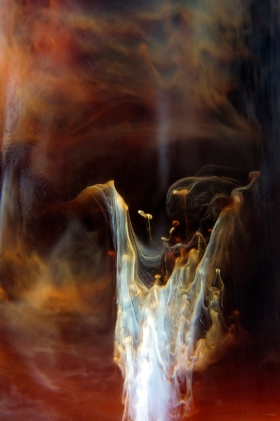
“Javascapes” by Photographer Daniel G. Walczyk. Source: http://devidsketchbook.com (Website link embedded within.)
I think men who love sweet-dry fragrances with strong spices, some darkness, light gourmand touches, a hint of tobacco and incense, all wrapped up in cozy warmth will go nuts for Coze. Women who don’t like syrupy fragrances but who love spicy orientals will thoroughly enjoy it as well. As for those who don’t like dark fragrances, I truly don’t think Coze qualifies. The expresso is really the tiniest touch, the incense is subtle, and the chocolate is more like powdered cocoa for the majority of Coze’s development. More importantly, the reformulation seems to have toned down Coze’s fiery bite from the pimento in the opening, so it would be easier now for those who don’t like a strong spice mix. That said, everyone needs to be aware of the cloves and patchouli. If you can’t bear either note, you should skip Coze.
For everyone else, I definitely think you should consider giving Coze a test sniff. It is really lovely as a cozy winter fragrance, though the light weight and airiness means you can wear it in summer, too. Even better, Coze is not hugely expensive. The smallest size (30 ml or 1 oz) costs $85 or €65, while the 50 ml bottle is $100, €92, or £81.50. The relatively moderate cost means that it’s not impractical to reapply Coze after 5 hours if you’re one of the people whose skin seems to eat up the scent. I loved it from the first sniff, and definitely plan to get a full bottle for myself. The sunny, golden warmth mixed with the rich spices and patchouli, the dusky chocolate and sweet vanilla, the light threads of honey drizzled blond tobacco and incense… fantastic!




